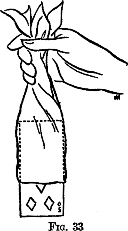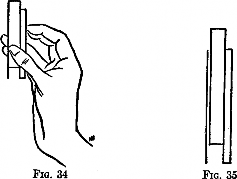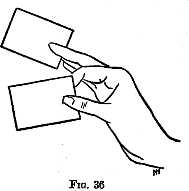
3. FIVE CARD DISCOVERIES
The great majority of card tricks are based on the discovery—in more or less startling ways—of a card which has been freely chosen by a spectator, returned to the pack, and buried (“drowned,” as the French say) therein.
Instead of completing a trick with one card, then proceeding to have another card drawn and doing a trick with that one, and so on, it is much more effective to have several cards chosen and returned to the pack before going on with the discovery processes. Not only does this procedure save time, always valuable, and so help to keep the attention of the audience, but it adds greatly to the effect—for it appears impossible to the layman that a number of cards can be controlled and produced separately when the pack is being constantly mixed up in the production of each card. Two sequences providing for the discoveries of five cards follow. These will serve as models from which the reader can arrange combinations of his own.
Combination of four tricks. Hand the deck to a spectator, A, with the request that he shuffle it, take out one card, and give the pack back to you. Do the same with four other persons, B, C, D, and E. Ask all five to note and remember their cards. Beginning with the last man, E, have the chosen cards returned to the deck in the course of a Hindu shuffle (see page 286), controlling them and finishing the shuffle with the five cards on the top of the deck in the order in which they were drawn. You can now execute a false shuffle or palm off the five cards and have the pack shuffled by a spectator.
In either case, with the five chosen cards on the top, place the pack in your breast pocket and proceed to give an exhibition of the development of your sense of touch. Explain that in handling the card the personal vibrations of the drawer were transmitted to it, and that by means of them you will find the card in the shuffled pack. To make the task harder ask A to name a small number at which he would like you to find his card. Suppose that seven is called. Six times in succession you take cards from the bottom of the deck; then, for the seventh, touch his fingers to get the right vibrations, dive your hand into the pocket, and bring out the top card. Hold it face down and ask A to name his card, which you slowly turn face up. Take the rest of the cards from the pocket, put the seven cards on the bottom, and go to the second spectator, B.

Ask for the loan of his handkerchief; as he takes it from his pocket, palm the top card and take the pack in the same hand. Receive the handkerchief with the left hand, taking it by a corner. Transfer the pack to the left hand, take the opposite corner in the right hand, and stretch the handkerchief out; then cross your arms to show the other side. Let the fabric fall over the right hand and with the left hand lay the deck on the middle, immediately over the palmed card; grip it through the handkerchief with the right hand, holding the pack vertically, the bottom card facing the audience. With the left hand draw the upper part of the handkerchief over the pack, so that it hangs down in front; push the folds at the top of the deck on each side to the back, so that they partly cover and hold B’s card in place; and grasp the whole at the top with the left hand. Run the right hand down the folds of the handkerchief below the pack, twist them together, and hold them; turn the pack down sideways with the left hand, release it, and hold the handkerchief with the right hand (Fig. 33).
Invite B to name his card. Order it to penetrate the handkerchief and show itself. A slight up-and-down shake with the right hand will cause the card to free itself from the folds and appear gradually, as if working its way through the handkerchief. Let it flutter to the floor, seize the lower end of the pack through the fabric with the left hand, turn the hand over, and show that the deck was fairly wrapped up. Return the handkerchief and proceed to C.

Execute another false shuffle, leaving the three top cards intact. Place the cards in the right hand in the position shown in Figure 34, at the same time pulling about onethird of the pack down at the back (making a step) and spreading the face cards down a little to hide it. Fig. 35 shows a side view of the arrangement. Ask C to name his card and order it to rise from the middle of the deck. With the tips of the right first and second fingers push the rear card— C’s card—slowly upwards with a regular movement. When its lower edge has arrived at the top of the step, seize the card and the top of the deck with the left hand, press the bottom edge of the card against the step, square the pack by pressing it down on the right palm, remove the pack with the left hand, and show the card protruding from the middle of the deck.
Push the card into the pack, remarking, “Well, that completes my trick. I have found the cards each in a different way.” Turn to your table, run the top card to the bottom, and put the pack down. Naturally, D and E remind you that they also drew cards. Pretend to be embarrassed by the oversight. Point out that the pack has left your hands, that you have lost contact with the vibrations, and so on. “I don’t like to try it,” you continue, “but there is only one course left—that is to rely upon chance. I will throw the whole pack into the air and try to catch the two chosen cards from amongst the whole fifty-two cards.”
Take the pack in the right hand, the thumb on the face of the bottom card, fingers on the back of the top card. Squeeze the pack rather tightly; lower the right hand, then jerk it upwards sharply, retaining the top and bottom cards and letting all the intervening cards slip upwards; grip the two cards tightly and with the same hand strike the pack, scattering the cards in all directions. At once slide the two cards apart by pushing the face card upwards with the thumb; slip the first and second fingers between them and grip one between the thumb and forefinger, the other between the second and third fingers (Fig. 36). Hold the cards with their backs to the spectators and ask D and E to name their cards. Turn the faces of the two cards and show that you have succeeded.

This last catch is easier, cleaner, and more effective than the old method of wetting the thumb and fingers to make the cards stick to them.
Annemann’s five card findo. I am indebted to Mr. Theodore Annemann for permission to describe this series of five discoveries which appeared in his famous monthly The Jinx. The arrangement is an excellent one and the various subtleties introduced should be carefully studied.
Five cards are freely chosen by five spectators, whom we will again call A, B, C, D, and E; Mr. Annemann prefers that the first person shall be a lady. Control the cards and bring them to the top of the pack in the order of choice by means of the Hindu shuffle (see page 286). Then execute an overhand shuffle, running seven cards onto the top of the pack; jog the next card and shuffle off. Make a break at the jog; shuffle to the break and throw the rest of the cards on top, thus making A’s card the eighth card from the top, the other four remaining in order below it.
Invite A to step forwards beside you and name a number between one and ten. In the meantime you have slipped the tip of the left little finger below the two top cards, which prepares you for the numbers five, six, seven, and eight. If four, or a smaller number, is named, merely remark, “It should be a more difficult one,” and a higher number is then certain to be named. If five is chosen, deal the first two cards as one onto A’s hand, then single cards at two, three, four, and five; point to the top card and have the card named. Make a double lift and the eighth card, A’s card, shows. If the number chosen is, six, deal two cards as one to start with and, after dealing five more cards one at a time, let the lady name her card and turn it over herself on top of the deck. If seven, deal fairly throughout and have her turn the top card; if eight, deal seven cards and have the eighth turned. In any case, place the eight cards on the bottom of the pack so that B’s card becomes the top card.
B now steps forwards and stands at your left. Hand the deck to him, instruct him to deal the cards onto your left hand, and, when he has dealt the fourth card, say, “And you may stop dealing at any time you like. It’s entirely up to you.” When he stops, push off the last card he dealt with your left thumb, take it with the right hand, and shake it a little without showing its face—as if merely to draw attention to it—as you continue, “This is as far as you want to go?” and drop the card carelessly on top of the packet again. Look directly at B; with the left second finger push out the bottom card (his card) a trifle and press the tip of the left thumb against the tip of this second finger. As he replies and while you are still looking at him, bring the right hand over, take the bottom card, and move the left hand away as you say, “Then tell everybody what card you looked at.” Stretch your right hand out to the right at full length and, as he names his card, slowly turn its face to the audience with the fingers only, moving neither the hand nor the arm.
Put B’s card on the cards in the left hand, take the rest of the pack from him, and place them on top of the packet in the left hand. The three remaining selected cards are now on the bottom of the pack in order, from the face card up. B retires and C steps forwards. Hand him the top card of the pack, saying, “Is this the card you took, sir? No? I’m glad it isn’t, for my finding it might lead you to suspect that I am merely deceiving you with card tricks. You appear to be a rather difficult subject, so we’ll leave everything to chance this time. Use the card as an indicator and push it face up into the pack, anywhere you please.” In the meantime you have undercut—that is to say, drawn out from the bottom—about fifteen cards, placed them on the top of the pack, and slipped the tip of the left little finger below them.
Riffle the ends of the cards for the insertion of the indicator card and let the rest fall on top of it. Raise the pack to a vertical position, push up the packet above the little finger, grasp it and the indicator card together with the right hand, and draw the hands apart. The indicator card then lies directly against the face of C’s card; remove the indicator as C names his card. As C returns to his seat and D comes forwards, put the packet in the right hand below the cards in the left hand and move C’s card and the indicator card to the top. The fourth and fifth chosen cards are now on the bottom and again you cut the pack, holding a break with the tip of the left little finger. Hold the deck in the left hand at arm’s length to the left. Tell the spectator he is to think of his card, watch you riffle slowly through the pack, and, when he feels an uncontrollable impulse, he is to call “Stop.” Bend the left forefinger under the pack and with the thumb riffle the left outer corners of the cards in such a way that the audience can see the action.
When D calls “Stop,” don’t move either the hand or the arm; turn your head to him and say, “Are you sure that was a real impulse? You may try again if you like. It’s up to you.” When he is satisfied, bring the left arm down in front of “you with a swing, tipping the pack down with the backs of the cards toward the spectators. With the right hand, the thumb at the back, the fingers in front, lift off the packet above the break. D names his card and you turn the packet over slowly to reveal it.
D retires and, as E comes up, place the packet in the right hand underneath that in the left and move D’s card to the top. Sight the bottom card, E’s card; make an overhand shuffle, bringing it to the top; and slip the tip of the left little finger under the second card. If E’s card is a red one, you say to him, “Was your card a black one?” If it was a black one, ask him, “Was your card a red card?” thus insuring that the answer will be “No.” Explain that that leaves you up against a stone wall and that the card will have to be left to find itself. Continue, “Will you see that your card is amongst the others as I fan them through?” Keep the first two cards together, thus concealing his card; and, as you fan the cards, spell out its name, remembering to take two letters for the first two cards taken off as one card. When you reach the card on the last letter, put the right forefinger on it in front and keep on fanning the cards against that finger. With the right thumb push the top card toward the left at the back of the fan, then with the left thumb pull it further along; push back the right forefinger to make an opening in the fan, into which the card slips as you gather the cards together.
Ask E if he has seen his card. You know the answer will be “No” and you hand the deck to him, telling him to look through it and see that his card is really there. He does this and you tell him to keep the deck and name his card aloud.
Instruct him to deal the cards face down onto your hand and as he does so you spell the name of his card. Stop him on the last letter and have him turn the card himself. Climax.
Website Content: © Copyright 2024 by Trickshop.com.